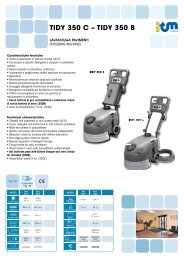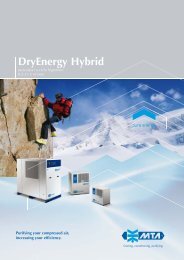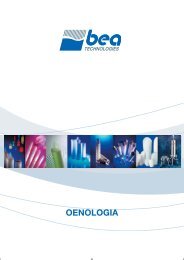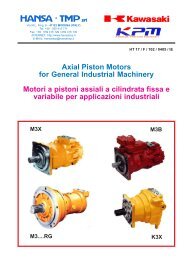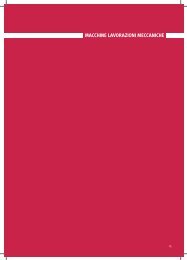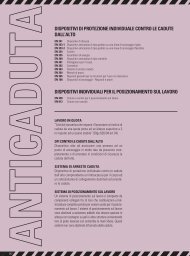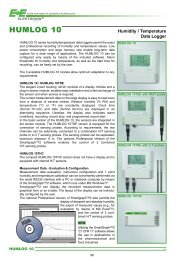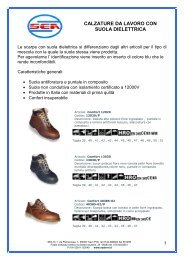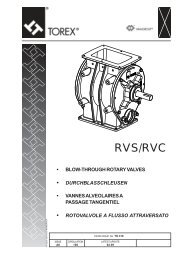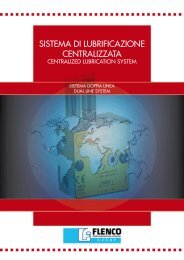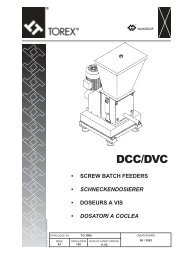Motori Pneumatici Pneumatic Motors Druckluftmotoren - Sea
Motori Pneumatici Pneumatic Motors Druckluftmotoren - Sea
Motori Pneumatici Pneumatic Motors Druckluftmotoren - Sea
You also want an ePaper? Increase the reach of your titles
YUMPU automatically turns print PDFs into web optimized ePapers that Google loves.
<strong>Motori</strong> pneumatici - <strong>Pneumatic</strong> motors - <strong>Druckluftmotoren</strong><br />
SEMPLICITÀ COSTRUTTIVA<br />
I motori pneumatici sono costituiti da un ridotto<br />
numero di componenti. Ne deriva quindi una<br />
lunga durata ed una facile manutenzione.<br />
ALTA ADATTABILITÀ ALLE CONDIZIONI<br />
AMBIENTALI<br />
La tecnica costruttiva e l’impiego a pressione<br />
superiore a quella dell’ambiente garantiscono<br />
un utilizzo effi cace in ambienti polverosi o<br />
umidi. Inoltre, per le applicazioni nelle quali<br />
è richiesto un elevato isolamento tra motore<br />
ed ambiente circostante sono disponibili<br />
versioni specifi che.<br />
SICUREZZA<br />
Il motore pneumatico, nelle normali condizioni<br />
di funzionamento, non produce scintille o<br />
surriscaldamenti e, non avendo connessione<br />
diretta a corrente elettrica, non è soggetto a<br />
pericolo di corto circuito.<br />
Il sistema di alimentazione è pertanto esente<br />
da pericolo di folgorazioni.<br />
Adottando gli opportuni accorgimenti, si può<br />
usare anche in ambienti infi ammabili, come<br />
nel caso della miscelazione di solventi, vernici,<br />
ecc...<br />
PRESSIONE DI ESERCIZIO<br />
La pressione nominale di esercizio dei motori<br />
pneumatici è 6 bar. Il motore pneumatico si<br />
sceglie in base a tre parametri fondamentali:<br />
POTENZA, VELOCITÀ e COPPIA.<br />
Le curve caratteristiche, riportate per ogni<br />
motore, mettono in relazione tra loro questi<br />
parametri. È possibile utilizzare i motori a<br />
pressioni diverse da quella nominale, sapendo<br />
che valori inferiori determinano cali di potenza,<br />
e valori superiori non hanno pressoché<br />
infl uenza sulle caratteristiche tecniche ma<br />
possono abbreviare la vita del motore.<br />
Nella seguente tabella evidenziamo le diverse<br />
prestazioni al variare della pressione:<br />
SIMPLE CONSTRUCTION<br />
<strong>Pneumatic</strong> motors have a small number<br />
of components. This feature makes these<br />
motors long-lasting and easy to maintain.<br />
VERY ADAPTABLE TO ENVIRONMENTAL<br />
CONDITIONS<br />
Design features and operating at pressures<br />
higher than ambient pressure will ensure<br />
that a pneumatic motor continues to<br />
operate effi ciently in very dusty or humid<br />
conditions. Special versions are also<br />
available for those applications where<br />
a high degree of insulation between the<br />
motor and the surrounding environment<br />
is required.<br />
SAFETY<br />
Under normal operating conditions a<br />
pneumatic motor does not produce sparks<br />
and will not overheat. This combined with<br />
the fact the motor is not connected directly<br />
to an electrical power source means that<br />
there is no risk of a short-circuit. There is<br />
therefore no risk of electrocution from the<br />
power supply system. With the right design<br />
features, pneumatic motors can be used to<br />
operate in fl ammable environments. The<br />
could be used, for example, where solvents<br />
and paints are mixed.<br />
OPERATING PRESSURE<br />
The rated operated pressure of pneumatic<br />
motors is 6 bar. <strong>Pneumatic</strong> motors are<br />
chosen taking into consideration three<br />
basic parameters: POWER, SPEED and<br />
TORQUE. The performance figures for<br />
each motor show the relationship between<br />
these parameters. <strong>Motors</strong> can be used at<br />
below their rated pressures but this will<br />
cause power output reductions. Using<br />
motors at above their rated pressure will<br />
have practically no infl uence on technical<br />
performance but will shorten motor life.<br />
The table below shows the changes in<br />
performance as pressure varies:<br />
EINFACHE KONSTRUKTION<br />
<strong>Druckluftmotoren</strong> bestehen aus wenigen<br />
Bauteilen. Daraus ergeben sich lange<br />
Lebensdauer und einfache Wartung.<br />
ANPASSUNGSFÄHIGKEIT AN DIE<br />
UMGEBUNGS BEDINGUNGEN<br />
Die Bauweise und der Einsatz bei Überdruck<br />
gewährleisten einen effektiven Einsatz<br />
in staubiger und feuchter Umgebung.<br />
Für Anwendungen, bei denen eine hohe<br />
Isolierung zwischen Motor und Umgebung<br />
erforderlich ist, sind entsprechende<br />
Sonderausführungen erhältlich.<br />
SICHERHEIT<br />
<strong>Druckluftmotoren</strong> erzeugen unter<br />
normalen Betriebsbedingungen weder<br />
Funken noch Überhitzung und laufen<br />
auch keine Kurzschlussgefahr, da kein<br />
direkter Stromanschluss besteht. Dadurch<br />
besteht auch keine Stromschlaggefahr.<br />
Wenn die entsprechenden Vorkehrungen<br />
getroffen werden, kann dieser Motor auch<br />
in Anwesenheit leicht entzündlicher Stoffe,<br />
wie z.B. beim Mischen von Lösungsmitteln,<br />
Lacken usw., verwendet werden.<br />
BETRIEBSDRUCK<br />
Der Nennbetriebsdruck der Luftmotoren<br />
beträgt 6 bar. Die Wahl eines<br />
Druckluftmotors erfolgt aufgrund von drei<br />
Grundgrößen: LEISTUNG, DREHZAHL und<br />
DREHMOMENT. Die Kennlinien, die für<br />
jeden Motor angegeben werden, stellen die<br />
Beziehung zwischen diesen Größen her.<br />
Die Motoren können mit anderen Drücken<br />
als dem Nenndruck betrieben werden;<br />
dabei ist zu beachten, dass niedrigere<br />
Werte zu einem Leistungsabfall führen,<br />
während höhere Werte die technischen<br />
Eigenschaften kaum beeinfl ussen, aber zu<br />
einer Verkürzung der Lebensdauer führen<br />
können.<br />
In der folgenden Tabelle sind die<br />
unterschiedlichen Leistungen bei Änderung<br />
des Drucks zusammengefasst:<br />
Pressione (bar)<br />
Pressure (bar)<br />
Druck (bar)<br />
Potenza<br />
Power<br />
Leistung<br />
Coppia<br />
Torque<br />
Drehmoment<br />
Velocità<br />
Speed<br />
Drehzahl<br />
Consumo<br />
Consumption<br />
Verbrauch<br />
7 1,21 1,17 1,03 1,15<br />
6 1 1 1 1<br />
5 0,77 0,83 0,95 0,82<br />
4 0,55 0,67 0,87 0,65<br />
3 0,37 0,5 0,74 0,47<br />
Tabella di conversione - Conversion table - Umrechnungstabelle<br />
1 Hp = 735,3 watt 1 Kg/m = 10 Nm 1 bar = 14,5 psi<br />
7.4



